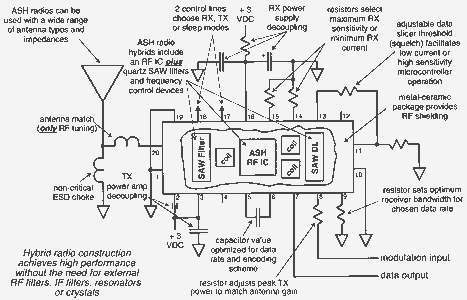
RF Monolithics (RFM) manufactures and markets RF components and sub-assemblies based on SAW technology. The company offers products in four rapidly growing areas - low-power components, virtual wire radio systems, frequency control modules and filters. One of RFM's latest product lines is its new second-generation virtual wire ASH short range radios. This product line includes miniature transmitter, receiver and transceiver hybrids, plus OEM data radio boards and related protocol firmware and development kits.
The flagship of the range is the ASH transceiver which addressses the rapidly growing requirement for short-range, two-way data communications. These products are used to implement short range wireless data communication and control links in a wide range of applications. Examples of some applications are: handheld and body-worn computers; wireless barcode readers and receipt printers; automatic utility meter reading systems; home entertainment systems and electronic games; home and industrial automation systems; automotive keyless entry and wireless security systems; industrial telemetry, RFID tags and access control badges.
Features
RFM's second-generation radio products are based on an enhanced version of its proprietary amplifier-sequenced hybrid (ASH) radio architecture which has been specifically developed to provide the features needed by modern short-range data radio applications. Some of these features are:
* Data rates up to 115,2 Kbps.
* Stable sensitive receiver technology with good 'channel capture' performance.
* Low current consumption for operation from 3 V batteries.
* Very small low profile package.
* Integrated quartz SAW filtering and frequency control components.
* Rugged self-shielding, metal-ceramic hybrid package.
* Wide operating temperature range.
* Easy certification to stringent short range radio regulatory requirements.
The integration of the RF IC with its SAW filtering and frequency control devices in a single hybrid greatly simplifies and speeds the RF design task. External RF filters, IF filters, resonators and crystals are thus not required. All critical interconnections between the IC and the filtering and frequency control devices are implemented in a self-shielding hybrid package. These radio transceivers are also optimised for a given application by selecting noncritical components. This allows customers without extensive RF experience to successfully implement wireless links using ASH radio technology.

Specifications
RFM's second-generation ASH transceivers have the following specifications: data rate 115,2 Kbps max; peak TX output 0,75 mW; supply voltage 2,7 to 3,5 V d.c.; ave. RX current 12 mA. Frequencies (in MHz) are: 916,50 (TR1000); 868,35 (TR1001); 433,92 (TR3000); 315,00 (TR3001); 418,00 (TR3002); 303,83 (TR3003). Package styles are SM-20L (2,03 x 9,91 x 11,2 mm) for the TR3000 through TR3003, and SM-20H (2,03 x 7,06 x 10,2 mm) for the TR1000 and TR1001.

© Technews Publishing (Pty) Ltd | All Rights Reserved